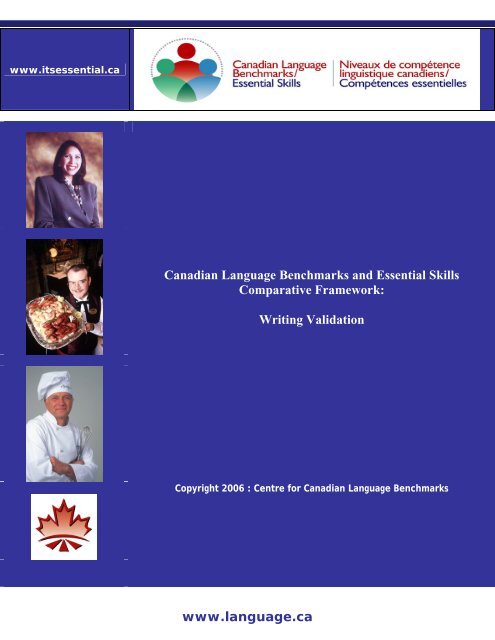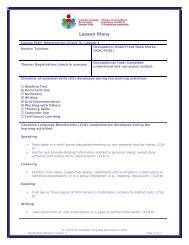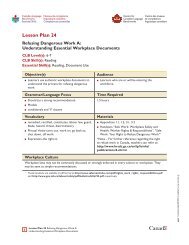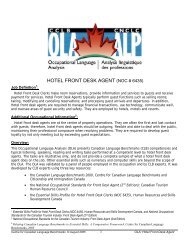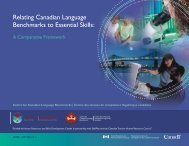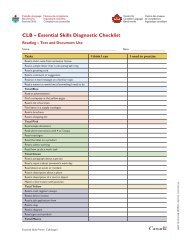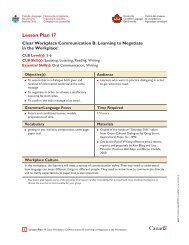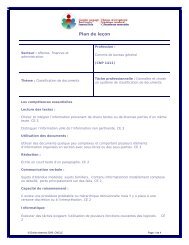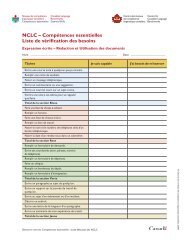Informal report on writing validation - Canadian Language ...
Informal report on writing validation - Canadian Language ...
Informal report on writing validation - Canadian Language ...
You also want an ePaper? Increase the reach of your titles
YUMPU automatically turns print PDFs into web optimized ePapers that Google loves.
www.itsessential.ca<strong>Canadian</strong> <strong>Language</strong> Benchmarks and Essential SkillsComparative Framework:Writing Validati<strong>on</strong>Copyright 2006 : Centre for <strong>Canadian</strong> <strong>Language</strong> Benchmarkswww.language.ca
Executive SummaryIn 2002, a project was initiated to investigate the relati<strong>on</strong>ship between the <strong>Canadian</strong> <strong>Language</strong>Benchmarks (CLB) and the Essential Skills (ES). Out of this investigati<strong>on</strong>, the Centre for<strong>Canadian</strong> <strong>Language</strong> Benchmarks (CCLB), in c<strong>on</strong>sultati<strong>on</strong> with the BC C<strong>on</strong>structi<strong>on</strong> IndustrySkills Improvement Council (SkillPlan), produced a Comparative Framework (CF) thatrepresented the first draft attempt to align the skills and competencies reflected in these tw<strong>on</strong>ati<strong>on</strong>al standards. This <str<strong>on</strong>g>report</str<strong>on</strong>g> describes a small study that was c<strong>on</strong>ducted to investigate thevalidity of the CF Writing alignment table. This work follows earlier research that focused <strong>on</strong> theutility and accuracy of the CF Reading alignment table.The methodology used for this validati<strong>on</strong> was to draft 25 samples of various complexity levelsand workplace situati<strong>on</strong>s, which were evaluated by 2 experts in Essential Skills. After someminor revisi<strong>on</strong>s (e.g. clarity), 23 samples were selected for the pilot. Tasks and a rating sheetwere sent out to 15 CLB experts (participants), with additi<strong>on</strong>al instructi<strong>on</strong>s to benchmark someexample tasks to make sure the participants were clear <strong>on</strong> the process of review and rating thatwas to be followed. Tasks were then rated independently and remotely by the participants, whomailed back their forms to the researchers.All benchmark ratings were assigned and delivered by the 15 CLB experts <strong>on</strong> the 23 <strong>writing</strong>tasks. In summary, ratings tend to be closer to expectati<strong>on</strong>s at both ends of the difficultyc<strong>on</strong>tinuum, where judgments might be expected to be easier. In the middle ranges, ratingaccuracy is not very good. Raters tend to disagree by assigning ratings higher rather than lowerthan expected, with <strong>on</strong>e excepti<strong>on</strong>, as noted, Item K. Assuming that a CLB-ES alignment isacceptable if 80% of raters can agree within the <strong>on</strong>e-benchmark margin, we can then identify thetasks where this is not the case. The standard of agreement is not met in tasks V, F, S, C, E, L,and W. In these cases, between 25% and 100% of judges were outside this range of tolerance.Most of these tasks are at ES levels 3 and 4. Overall, at ES level 3, more than 25% of ratings aretoo high by more than <strong>on</strong>e benchmark, and at ES level 4, this figure is almost 50%.The tendency for raters to perceive tasks as more difficult than target may be due to the fact thatthe CLB, unlike the ES, is designed to take into account the sec<strong>on</strong>d-language and sec<strong>on</strong>d-cultureinterpretati<strong>on</strong> of a task. While the rating system for ES is quite straight-forward, focusing <strong>on</strong>ly <strong>on</strong>the complexity of the task itself, the rating system for the CLB requires a careful c<strong>on</strong>siderati<strong>on</strong> ofall variables that might impact a sec<strong>on</strong>d-language learner who attempts to perform the task in acultural setting that is less than familiar. Although the assignment instructi<strong>on</strong>s advised CLBexperts to assume that the writer performing the task would be sufficiently familiar with theoccupati<strong>on</strong>al and situati<strong>on</strong>al requirements of the target workplace, in reality it might have beenquite difficult for these ESL professi<strong>on</strong>als to screen out the cultural and c<strong>on</strong>textual features of thetask. As part of the discussi<strong>on</strong>, two possible models are proposed for the Writing alignment table.Results of this small study seem to indicate the need for a rec<strong>on</strong>siderati<strong>on</strong> of the c<strong>on</strong>cordancepresented in the Comparative Framework Writing alignment table. It appears that a greaterdegree of accuracy could be achieved in the task alignments if the existing Writing table were tobe replaced with a somewhat looser model, <strong>on</strong>e that acknowledges the degree of error associatedwith rating workplace tasks <strong>on</strong> the <strong>Canadian</strong> <strong>Language</strong> Benchmarks, <strong>on</strong>e that also better reflectsthe fluidity and imprecisi<strong>on</strong> of the relati<strong>on</strong>ship between the two underlying scales.
Table of C<strong>on</strong>tentsIntroducti<strong>on</strong>………………………………………………………………………………1Methodology…………………………………………………………………………….. 2Analysis…………………………………………………………………………………..4Discussi<strong>on</strong> ………………………………………………………………………………..8C<strong>on</strong>clusi<strong>on</strong>……………………………………………………………………………….15Appendix A………………………………………………………………………16Appendix B………………………………………………………………………25Appendix C………………………………………………………………………26Appendix D………………………………………………………………………28Appendix E………………………………………………………………………29Appendix F……………………………………………………………………….34Appendix G………………………………………………………………………35
CLB-ES Comparative FrameworkWriting Validati<strong>on</strong> StudyGail StewartPhilip NagyJanuary 19, 2006Introducti<strong>on</strong>In 2002, a project was initiated to investigate the relati<strong>on</strong>ship between the <strong>Canadian</strong> <strong>Language</strong>Benchmarks (CLB) and the Essential Skills (ES). Out of this investigati<strong>on</strong>, the BCC<strong>on</strong>structi<strong>on</strong> Industry Skills Improvement Council (SkillPlan), in c<strong>on</strong>sultati<strong>on</strong> with the Centrefor <strong>Canadian</strong> <strong>Language</strong> Benchmarks (CCLB), produced a Comparative Framework (CF) thatrepresented the first draft attempt to align the skills and competencies reflected in these tw<strong>on</strong>ati<strong>on</strong>al standards. The intended purpose of the framework was to support the work ofEnglish as a Sec<strong>on</strong>d <strong>Language</strong> (ESL) practiti<strong>on</strong>ers by assisting them in selecting suitableworkplace c<strong>on</strong>tent for use in CLB-based language classrooms and training programs.This <str<strong>on</strong>g>report</str<strong>on</strong>g> describes a small study that was c<strong>on</strong>ducted to investigate the validity of the CFWriting alignment table. This work follows earlier research that focused <strong>on</strong> the utility andaccuracy of the CF Reading alignment table. In the Reading study, practiti<strong>on</strong>ers were askedto use the Reading table for its intended purpose and to <str<strong>on</strong>g>report</str<strong>on</strong>g> <strong>on</strong> their experiences. Theywere also asked to provide feedback <strong>on</strong> the comprehensiveness, clarity, and accuracy of anintroducti<strong>on</strong> that had been written to go al<strong>on</strong>g with the framework. In additi<strong>on</strong>, the Readingstudy resp<strong>on</strong>dents were assembled into panels to undertake a task alignment activity and tooffer commentary <strong>on</strong> the inherent value of the CF c<strong>on</strong>cept.Results of the Reading study revealed a positive resp<strong>on</strong>se to the existence of a c<strong>on</strong>crete toolthat would assist ESL practiti<strong>on</strong>ers in understanding the complex relati<strong>on</strong>ship between theCLB-ES Comparative Framework1Writing Validati<strong>on</strong> Study© Centre for <strong>Canadian</strong> <strong>Language</strong> Benchmarks: 2006
CLB and the ES. Participants in the study offered a great deal of support for the CF and alsoprovided much anecdotal feedback to suggest ways in which the framework might beclarified, fleshed out, and improved.The Reading study resulted in such a rich qualitative resp<strong>on</strong>se that we did not see thenecessity to inquire again as to the overall value and utility of the Comparative Framework.Because there is already sufficient evidence to indicate that the field supports the existence ofthe CF and endorses its c<strong>on</strong>ceptual underpinning, we chose in this study to focus solely <strong>on</strong> theissue of accuracy.MethodologyThe study was designed as follows.1. Twenty-five workplace-oriented Writing tasks were drafted to represent a range ofcomplexities and a variety of occupati<strong>on</strong>al situati<strong>on</strong>s.2. The draft tasks were examined and evaluated by two expert raters who have extensivebackground and experience in developing ES profiles. Complexity ratings wereassigned independently by these experts, who then c<strong>on</strong>ferred to reach c<strong>on</strong>sensus.Where any ambiguity existed, the raters suggested modificati<strong>on</strong>s that would make thetasks more easily ratable. The perspective taken in this <str<strong>on</strong>g>report</str<strong>on</strong>g> is that the ES ratingsassigned by the two experts are accurate.3. The Writing tasks were further refined for c<strong>on</strong>sistency and clarity, and twenty-three ofthem were selected (see Appendix A) to represent a range of ES complexities (seeAppendix B).CLB-ES Comparative Framework2Writing Validati<strong>on</strong> Study© Centre for <strong>Canadian</strong> <strong>Language</strong> Benchmarks: 2006
4. The tasks and instructi<strong>on</strong>s for rating (see Appendix C) were sent out to a CLBresp<strong>on</strong>dent group comprising experts with a str<strong>on</strong>g working knowledge andunderstanding of the <strong>Canadian</strong> <strong>Language</strong> Benchmarks.5. Before carrying out their rating assignment, the CLB expert group engaged in abenchmarking sessi<strong>on</strong>. The sessi<strong>on</strong> was c<strong>on</strong>ducted by telec<strong>on</strong>ference using tasks thathad not been assigned any previous ES or CLB ratings (see Appendix D). Thepurpose of this benchmarking sessi<strong>on</strong> was to ensure that all of the CLB experts wouldc<strong>on</strong>sistently follow the instructi<strong>on</strong>s for their task rating assignment. Following thetelec<strong>on</strong>ference, all of the experts received a summary of the group’s benchmarkratings, al<strong>on</strong>g with a rati<strong>on</strong>ale for each decisi<strong>on</strong> (see Appendix E).6. Each CLB expert then undertook the assignment of determining an independentbenchmark rating for each of the twenty-three Writing tasks. As stipulated in theassignment instructi<strong>on</strong>s, these ratings were to reflect the lowest CLB Writing levelnecessary to fulfil the requirements of each task in a workplace setting. Ratings wererecorded <strong>on</strong> resp<strong>on</strong>se sheets (see Appendix F), which were collected for analysis.7. The independent ratings were analyzed with reference to Table 1, the c<strong>on</strong>cordance setout in the Comparative Framework Writing table.Table 1: Target Matches Based <strong>on</strong> the ES-CLB Comparative FrameworkCLB 1 2 3 4 5 6 7 8 9 10 11 12ES 1ES 2ES 3ES 4ES 5Based <strong>on</strong> this c<strong>on</strong>cordance, the expected CLB ratings for the tasks in the study aresummarized in Appendix G.CLB-ES Comparative Framework3Writing Validati<strong>on</strong> Study© Centre for <strong>Canadian</strong> <strong>Language</strong> Benchmarks: 2006
AnalysisAll benchmark ratings were assigned and delivered by the 15 CLB experts <strong>on</strong> the 23 <strong>writing</strong>tasks. In three cases, a rater gave a pair of ratings (e.g., 6/7). In each case, the lower ratingwas chosen for analysis, in accordance with the rating instructi<strong>on</strong>s, which asked participantsto name the lowest benchmark level at which an individual might expect to be successful atthe task.Two of the 15 resp<strong>on</strong>dents were unable to attend the training telec<strong>on</strong>ference and went aheadwith their rating assignments before reading the feedback summary. In order to investigatewhether they might have misunderstood the assignment, an analysis was undertaken todetermine whether or not their ratings were comparable to those of other resp<strong>on</strong>dents. Theaverage ratings fell into three clusters: there were two averages at 7.0, ten between 7.5 and8.2, and three between 8.6 and 8.8 (all figures rounded). The two average ratings of 7.0 wereproduced by the two resp<strong>on</strong>dents unable to attend the training. This might suggest that thesetwo ratings be excluded, but they were no more below the central tendency than were thecluster of three high averages above this central tendency. Therefore, their ratings have beenincluded, but flagged with superscripts, a ‘1’ indicating that the cell includes <strong>on</strong>e of theirratings, and ‘2’ that it includes both of their ratings. Perusal of the data shows that, whilethese two raters were almost always at the low end of the range for that task, in all but acouple of cases, they were not al<strong>on</strong>e.The main analysis was a comparis<strong>on</strong> for c<strong>on</strong>sistency across the 15 raters and for c<strong>on</strong>gruencewith the assigned ratings based <strong>on</strong> the Comparative Framework. Results appear in Table 2.Bolded entries fall within the expected benchmark range based <strong>on</strong> the ComparativeFramework Writing table, which was shown as Table 1.CLB-ES Comparative Framework4Writing Validati<strong>on</strong> Study© Centre for <strong>Canadian</strong> <strong>Language</strong> Benchmarks: 2006
Table 2: Benchmark Ratings as AssignedBenchmarkTask 2 3 4 5 6 7 8 9 10 11 12A 1 5 2 7 2B 2 1 7 5 1 1C 4 2 5 6D 3 1 6 1 4 2E 0 3 12 2F 1 2 1 6 1 2 4G 1 1 2 4 5 1 2 1H 2 1 7 1 2 3 1J 1 10 1 4 1K 3 1 3 3 1 6L 1 4 2 7 3M 1 1 2 5 1 6 1N 2 11 2 1 1P 1 1 2 1 10 1 1R 3 2 8 3 1S 3 1 4 5 1 2 1T 1 1 9 1 4 1U 4 1 6 5 1V 2 1 2 5 1 5 1W 2 1 9 1 2 2X 1 1 2 3 1 7 2Y 1 1 3 1 4 4 2 1Z 3 1 3 6 1 2 1Table 2 is difficult to use. In order to highlight patterns in these results, Table 3 presents areordering of the data by task difficulty and a grouping of resp<strong>on</strong>ses into categories. Since, <strong>on</strong>most low-stakes CLB placement assessments, an error of <strong>on</strong>e benchmark in either directi<strong>on</strong> isnot uncomm<strong>on</strong> and is c<strong>on</strong>sidered within the bounds of achievable accuracy <strong>on</strong> the CLB scale,we have created Table 3 to illustrate the proporti<strong>on</strong> of ratings at target, missing the target by<strong>on</strong>ly <strong>on</strong>e benchmark, and missing the target by two or more benchmarks.CLB-ES Comparative Framework5Writing Validati<strong>on</strong> Study© Centre for <strong>Canadian</strong> <strong>Language</strong> Benchmarks: 2006
Table 3: More Detailed Examinati<strong>on</strong> of RatingsAccuracy/BenchmarkBelow targetby 2 or moreBelow targetby 1At Target Above targetby 1Above targetby 2 or moreES1/BM 4-5B 0 2 12 0 1G 0 1 6 5 3N 0 0 13 1 1P 1 2 11 1 0R 0 3 11 1 0Z 0 0 6 6 3Benchmark % 1.1% 8.9% 65.6% 15.6% 8.9%ES2/BM 6-7H 0 2 9 3 1K 3 3 9 0 0M 0 1 7 6 1V * 0 0 4 5 6Y 1 3 8 2 1Benchmark % 5.3% 12.0% 49.3% 21.3% 12.0%ES3/BM 8A 0 1 5 7 2D 0 3 6 4 2F * 1 2 6 2 4S * 0 0 3 4 8Benchmark % 1.7% 10.0% 33.3% 28.3% 26.7%ES4/BM 9C * 0 0 4 5 6E * 0 0 0 0 15L * 0 0 1 4 10T 0 1 9 4 1W * 0 0 2 9 4Benchmark % 0.0% 1.3% 21.3% 29.3% 48.0%ES5/BM 10-12J 0 0 15 N/A N/AU 0 0 15 N/A N/AX 1 2 12 N/A N/ABenchmark % 2.2% 4.4% 93.3% N/A N/AOverall % 2.0% 7.5% 50.4% 20.0% 20.0%The asterisks * in Table 3 indicate instances where fewer than 80% of judgements are within<strong>on</strong>e benchmark of the acceptable range. The bottom row summarizes the levels of agreementfor all 23 tasks. Overall, 22% of ratings are off in either directi<strong>on</strong> by two or morebenchmarks. There is c<strong>on</strong>siderable asymmetry, with many more ratings above than belowtarget.CLB-ES Comparative Framework6Writing Validati<strong>on</strong> Study© Centre for <strong>Canadian</strong> <strong>Language</strong> Benchmarks: 2006
Further insight can be gained by examining the tasks by benchmark level, as illustrated in therows of Table 3 labeled “Benchmark %.” Disagreement is c<strong>on</strong>siderably worse in the middleof the difficulty range, at Benchmarks 8 and 9, than at the extremes. The pattern ofasymmetry persists throughout, with more high ratings than low, with <strong>on</strong>e notable excepti<strong>on</strong>,Item K, that has many more low ratings than ratings <strong>on</strong> target.In summary, ratings tend to be closer to expectati<strong>on</strong>s at both ends of the difficulty c<strong>on</strong>tinuum,where judgments might be expected to be easier. In the middle ranges, rating accuracy is notvery good. Raters tend to disagree by assigning ratings higher rather than lower thanexpected, with <strong>on</strong>e excepti<strong>on</strong>, as noted, Item K. Assuming that a CLB-ES alignment isacceptable if 80% of raters can agree within the <strong>on</strong>e-benchmark margin, we can then identifythe tasks where this is not the case. The standard of agreement is not met in tasks V, F, S, C,E, L, and W. In these cases, between 25% and 100% of judges were outside this range oftolerance. Most of these tasks are at ES levels 3 and 4. Overall, at ES level 3, more than 25%of ratings are too high by more than <strong>on</strong>e benchmark, and at ES level 4, this figure is almost50%.Discussi<strong>on</strong>The tendency for raters to perceive tasks as more difficult than target may be due to the factthat the CLB, unlike the ES, is designed to take into account the sec<strong>on</strong>d-language and sec<strong>on</strong>dcultureinterpretati<strong>on</strong> of a task. While the rating system for ES is quite straight-forward,focusing <strong>on</strong>ly <strong>on</strong> the complexity of the task itself, the rating system for the CLB requires acareful c<strong>on</strong>siderati<strong>on</strong> of all variables that might impact a sec<strong>on</strong>d-language learner whoattempts to perform the task in a cultural setting that is less than familiar. Although theassignment instructi<strong>on</strong>s advised CLB experts to assume that the writer performing the taskwould be sufficiently familiar with the occupati<strong>on</strong>al and situati<strong>on</strong>al requirements of the targetCLB-ES Comparative Framework7Writing Validati<strong>on</strong> Study© Centre for <strong>Canadian</strong> <strong>Language</strong> Benchmarks: 2006
workplace, in reality it might have been quite difficult for these ESL professi<strong>on</strong>als to screenout the cultural and c<strong>on</strong>textual features of the task.In the ES level 2 range (benchmarks 6-7), there is <strong>on</strong>ly <strong>on</strong>e task that elicits a high degree ofdisagreement (Task K, the <strong>on</strong>ly task where ratings were lower than target), and perhaps this isnot of great c<strong>on</strong>cern, as there may have been a specific feature of that particular task whichcaused our expert raters to perceive it as easier than target. However, at ES level 3(benchmark 8) and ES level 4 (benchmark 9), the levels of disagreement warrant furtherexaminati<strong>on</strong>.The main feature that stands out for ES levels 3 and 4 is the fact that <strong>on</strong>ly <strong>on</strong>e benchmark isassociated with each of these problematic ranges. In the draft Comparative Framework, ESlevel 3 is associated <strong>on</strong>ly with benchmark 8, and ES level 4 is associated <strong>on</strong>ly with benchmark9. This is perhaps too fine a distincti<strong>on</strong> to suggest in a c<strong>on</strong>cordance that is intended to capturewhat is in fact an imperfect and very complex relati<strong>on</strong>ship between two very different scales.We note also that the CLB is a 12-point scale, which leaves a much greater margin for errorthan does the 5-point ES scale.The existing draft CF Writing table implies precise distincti<strong>on</strong>s between c<strong>on</strong>tiguous levels,while our study seems to show that these distincti<strong>on</strong>s are perhaps not as clear as <strong>on</strong>e mightlike to believe. For this reas<strong>on</strong>, we have investigated the accuracy of two potentialreplacement tables that could depict the reality of a more fluid and flexible relati<strong>on</strong>shipbetween the two standards. The possible models are presented below.The first model represents an attempt to capture as fully as possible the broad range ofresp<strong>on</strong>se indicated by our CLB expert ratings. The advantage of this table is the fact that itclearly illustrates the complexity and imprecisi<strong>on</strong> of the CLB-ES relati<strong>on</strong>ship. Thedisadvantage is that there is a great degree of overlap, which might be c<strong>on</strong>fusing to potentialusers.CLB-ES Comparative Framework8Writing Validati<strong>on</strong> Study© Centre for <strong>Canadian</strong> <strong>Language</strong> Benchmarks: 2006
Table 4: ES/CLB Writing Matches, First Replacement Versi<strong>on</strong>CLB 1 2 3 4 5 6 7 8 9 10 11 12ES level 1ES level 2ES level 3ES level 4ES level 5If the above c<strong>on</strong>cordance is substituted for the existing Writing alignment table, then theresults of our CLB rating assignment change c<strong>on</strong>siderably. Tables 5 and 6 show the dramaticimprovement in the number of ratings <strong>on</strong> target when Table 4 is substituted for Table 1.Table 5: Alignments if First Replacement Framework (Table 4) is usedBenchmarkTask 2 3 4 5 6 7 8 9 10 11 12A 1 5 2 7 2B 2 1 7 5 1 1C 4 2 5 6D 3 1 6 1 4 2E 3 12 2F 1 2 1 6 1 2 4G 1 1 2 4 5 1 2 1H 2 1 7 1 2 3 1J 1 10 1 4 1K 3 1 3 3 1 6L 1 4 2 7 3M 1 1 2 5 1 6 1N 2 11 2 1 1P 1 1 2 1 10 1 1R 3 2 8 3 1S 3 1 4 5 1 2 1T 1 1 9 1 4 1U 4 1 6 5 1V 2 1 2 5 1 5 1W 2 1 9 1 2 2X 1 1 2 3 1 7 2Y 1 1 3 1 4 4 2 1Z 3 1 3 6 1 2 1CLB-ES Comparative Framework9Writing Validati<strong>on</strong> Study© Centre for <strong>Canadian</strong> <strong>Language</strong> Benchmarks: 2006
Table 6: More Detailed Examinati<strong>on</strong> of Ratings Using First Replacement ES/CLB MatchAccuracy/BenchmarkBelow targetby 2 or moreBelow targetby 1At Target Above targetby 1Above targetby 2 or moreES1/BM 3-6B 0 0 14 0 1G 0 0 12 2 1N 0 0 14 1 0P 0 1 14 0 0R 0 0 15 0 0Z 0 0 12 0 3Benchmark % 0% 1.1% 91.2% 3.3% 4.4%ES2/BM 5-8H 0 0 14 1 0K 0 3 12 0 0M 0 0 14 1 0V 0 0 9 5 1Y 1 0 13 1 0Benchmark % 1.3% 4.0% 82.7% 10.7% 1.3%ES3/BM 7-10A 0 0 15 0 0D 0 0 15 0 0F 0 1 14 0 0S 0 0 12 2 1Benchmark % 0.0% 1.6% 93.3% 3.3% 1.6%ES4/BM 9-12C 0 0 15 0 0E 0 0 15 0 0L 0 0 15 0 0T 0 1 14 0 0W 0 0 15 0 0Benchmark % 0.0% 1.3% 98.7% 0.0% 0.0%ES5/BM 10-12J 0 0 15 N/A N/AU 0 0 15 N/A N/AX 1 2 12 N/A N/ABenchmark % 0.0% 4.4% 93.3% N/A N/AOverall % 0.6% 2.3% 91.3% 3.8% 2.0%Examinati<strong>on</strong> of Table 6 shows that replacement of the existing CF Writing table byReplacement Table 4 produces a very high level of ratings <strong>on</strong> target. Overall, <strong>on</strong>ly 8.7% ofratings miss the target at all, and <strong>on</strong>ly 2.6% miss by more than <strong>on</strong>e benchmark. Only Task Zhas more than <strong>on</strong>e rating that misses the target by 2 or more benchmarks.CLB-ES Comparative Framework10Writing Validati<strong>on</strong> Study© Centre for <strong>Canadian</strong> <strong>Language</strong> Benchmarks: 2006
The disadvantage of using Table 4 is the fact that, as noted, this c<strong>on</strong>cordance implies a greatdeal of overlap between the levels in the two underlying standards. This feature of Table 4could lead users of the Comparative Framework to feel c<strong>on</strong>fused when trying to select tasksand materials for teaching and training purposes. Ultimately, a table that reflects too loose arelati<strong>on</strong>ship between the two scales is likely to be of little practical use.The sec<strong>on</strong>d model for a potential replacement table (Table 7) is an attempt to create acompromise between the overly tight c<strong>on</strong>cordance in Table 1 and the overly loose alignmentshown in Table 4. Table 7 presents a more uniform alignment of ranges <strong>on</strong> the two scales,with exactly three CLB benchmarks appearing at each ES level and an overlap of <strong>on</strong>ebenchmark between each range. The overlap is deliberate and is intended to reflect the <strong>on</strong>ebenchmarkallowable margin of error and also to acknowledge the imprecisi<strong>on</strong> of therelati<strong>on</strong>ship between the two underlying scales. Note that the degree of overlap inReplacement Table 7 is minimal compared to Replacement Table 4Table 7: ES/CLB Writing Matches, Sec<strong>on</strong>d Replacement Versi<strong>on</strong>CLB 1 2 3 4 5 6 7 8 9 10 11 12ES level 1ES level 2ES level 3ES level 4ES level 5If this sec<strong>on</strong>d realignment (Table 7) is used, then Tables 8 and 9 ensue. Table 8 presents thesame data as in Tables 2 and 5 but with more entries bolded than in Table 2 and fewer than inTable 5. This reflects the fact that Table 7 is a compromise between the very strict andprecise Table 1 and the much looser Table 4.CLB-ES Comparative Framework11Writing Validati<strong>on</strong> Study© Centre for <strong>Canadian</strong> <strong>Language</strong> Benchmarks: 2006
Table 8: Alignments if Sec<strong>on</strong>d Replacement Framework (Table 6) is usedBenchmarkTask 2 3 4 5 6 7 8 9 10 11 12A 1 5 2 7 2B 2 1 7 5 1 1C 4 2 5 6D 3 1 6 1 4 2E 3 12 2F 1 2 1 6 1 2 4G 1 1 2 4 5 1 2 1H 2 1 7 1 2 3 1J 1 10 1 4 1K 3 1 3 3 1 6L 1 4 2 7 3M 1 1 2 5 1 6 1N 2 11 2 1 1P 1 1 2 1 10 1 1R 3 2 8 3 1S 3 1 4 5 1 2 1T 1 1 9 1 4 1U 4 1 6 5 1V 2 1 2 5 1 5 1W 2 1 9 1 2 2X 1 1 2 3 1 7 2Y 1 1 3 1 4 4 2 1Z 3 1 3 6 1 2 1CLB-ES Comparative Framework12Writing Validati<strong>on</strong> Study© Centre for <strong>Canadian</strong> <strong>Language</strong> Benchmarks: 2006
Table 9: More Detailed Examinati<strong>on</strong> of Ratings Using Sec<strong>on</strong>d Replacement ES/CLB MatchAccuracy/BenchmarkBelow targetby 2 or moreBelow targetby 1At Target Above targetby 1Above targetby 2 or moreES1/BM 3-5B 0 0 14 0 1G 0 0 7 5 3N 0 0 13 1 1P 0 1 13 1 0R 0 0 14 1 0Z 0 0 6 6 3Benchmark % 0% 1.1% 74.4% 15.6% 8.9%ES2/BM 5-7H 0 0 11 3 1K 0 3 6 6 0M 0 0 8 6 1V 0 0 9 5 1Y 1 0 10 2 1Benchmark % 1.3% 4.0% 58.7% 29.3% 5.3%ES3/BM 7-9A 0 0 13 2 0D 0 0 13 2 0F 0 1 10 4 0S 0 0 7 5 3Benchmark % 0.0% 1.6% 71.2% 21.7% 5.0%ES4/BM 9-11C 0 0 15 0 0E 0 0 3 12 0L 0 0 12 3 0T 0 1 14 0 0W 0 0 13 2 0Benchmark % 0.0% 1.3% 76.0% 22.7% 0.0%ES5/BM 10-12J 0 0 15 N/A N/AU 0 0 15 N/A N/AX 1 2 12 N/A N/ABenchmark % 0.0% 4.4% 93.3% N/A N/AOverall % 0.6% 2.3% 73.9% 19.1% 4.1%In Table 9, <strong>on</strong>ly 4.7% of ratings are bey<strong>on</strong>d a tolerance of <strong>on</strong>e benchmark from thecompromise matches as shown in Table 6. Of the 95% within a <strong>on</strong>e benchmark tolerance,substantial asymmetry is shown, with 19.1% of ratings <strong>on</strong>e benchmark above target, and <strong>on</strong>ly2.3% <strong>on</strong>e benchmark below target. The disproporti<strong>on</strong>ate number of higher ratings isCLB-ES Comparative Framework13Writing Validati<strong>on</strong> Study© Centre for <strong>Canadian</strong> <strong>Language</strong> Benchmarks: 2006
probably due to CLB raters’ attenti<strong>on</strong> to variables bey<strong>on</strong>d linguistic ability that influenceperformance <strong>on</strong> authentic workplace tasks.C<strong>on</strong>clusi<strong>on</strong>Results of this small study seem to indicate the need for a rec<strong>on</strong>siderati<strong>on</strong> of the c<strong>on</strong>cordancepresented in the Comparative Framework Writing alignment table. It appears that a greaterdegree of accuracy could be achieved in the task alignments if the existing Writing table wereto be replaced with a somewhat looser model, <strong>on</strong>e that acknowledges the degree of errorassociated with rating workplace tasks <strong>on</strong> the <strong>Canadian</strong> <strong>Language</strong> Benchmarks, <strong>on</strong>e that alsobetter reflects the fluidity and imprecisi<strong>on</strong> of the relati<strong>on</strong>ship between the two underlyingscales.CLB-ES Comparative Framework14Writing Validati<strong>on</strong> Study© Centre for <strong>Canadian</strong> <strong>Language</strong> Benchmarks: 2006
Appendix ATask AYou are the senior manager in a company that manufactures windows. Last week, yourdepartment shipped out thirty-five windows (product # 34709). Some of the customers whoreceived the windows have called to inform you that there is a defect in the seal. Write a <strong>on</strong>epageletter to all of the customers who received the defective windows. Keeping in mind thatcustomers are usually upset by defects and delays, explain the nature of the defect, apologizefor the problem, and offer a suitable soluti<strong>on</strong>.Task BYou are a kitchen worker in a small restaurant. Every morning, you follow a set routine to getthe kitchen set up and ready for the day. Tomorrow, a co-worker will be filling in for you.Write a “to do” list with ten items to indicate the routine that the co-worker should follow insetting up for the day.1.To Do2.3.4.5.6.7.8.9.10.CLB-ES Comparative Framework15Writing Validati<strong>on</strong> Study© Centre for <strong>Canadian</strong> <strong>Language</strong> Benchmarks: 2006
Task CYou are the department manager at a large food processing company. You have d<strong>on</strong>e someresearch and have c<strong>on</strong>cluded that your department could be run more efficiently. Write adetailed <str<strong>on</strong>g>report</str<strong>on</strong>g> to the company president outlining your proposed changes. Include yourresearch results, recommendati<strong>on</strong>s, the reas<strong>on</strong>s why your ideas will work, and the benefits tothe company.Task DYou are a customer service agent for a small airline. Recently, a customer arrived at theboarding gate in a desperate hurry and tried to get <strong>on</strong> a flight without a boarding pass. Youfollowed procedure while trying to be polite yet firm, indicating that you could not allowany<strong>on</strong>e to board the plane without a valid pass. Now, the customer has registered a complaintabout your attitude. In a letter to the company president, the customer has stated that youwere rude and uncooperative. Write a letter to the president defending your behaviour.Describe the incident and explain your side of the story.Task EAs a senior HR manager at a telecommunicati<strong>on</strong>s company, you have been asked to draft acompany policy manual. This manual should include policies to deal with employee rightsand resp<strong>on</strong>sibilities, health and safety, working c<strong>on</strong>diti<strong>on</strong>s, and employee c<strong>on</strong>duct.Task FYou are an administrator at a medical clinic, and you have just managed to c<strong>on</strong>vince themanagement that you need a full-time assistant. Write a job descripti<strong>on</strong> for this new positi<strong>on</strong>.Task GYou are an elementary school teacher assistant working with a grade three class. One of thestudents is showing problems in her behaviour. Write a short note to the parents of thisstudent requesting a meeting to talk about the situati<strong>on</strong>.CLB-ES Comparative Framework16Writing Validati<strong>on</strong> Study© Centre for <strong>Canadian</strong> <strong>Language</strong> Benchmarks: 2006
Task HYou are a team leader in the shipping department of a large factory. Yesterday, a member ofyour team tried to get a box from a high shelf and fell off a ladder. As a result, she has abroken wrist and a bruised hip. Fill out the following <str<strong>on</strong>g>report</str<strong>on</strong>g> with details about the incident.Accidental Injury ReportBusiness unit: Department: Name of <str<strong>on</strong>g>report</str<strong>on</strong>g>ing team leader:Date of accident: Time of accident: Locati<strong>on</strong> of accident:Name of injured employee: Employee occupati<strong>on</strong>: Employeenumber:Employee startdate:How did the accident occur? (Please explain fully)What is the nature of the injury? (Please explain fully)Was the injury due to negligence? (Please explain fully)CLB-ES Comparative Framework17Writing Validati<strong>on</strong> Study© Centre for <strong>Canadian</strong> <strong>Language</strong> Benchmarks: 2006
Task JYou are a researcher who has recently completed a <strong>on</strong>e-year envir<strong>on</strong>mental impact study ofproposed development in a township currently z<strong>on</strong>ed for agricultural use. Prepare a detailed<str<strong>on</strong>g>report</str<strong>on</strong>g> to be presented to town council members. Your <str<strong>on</strong>g>report</str<strong>on</strong>g> should include several secti<strong>on</strong>s,including research methodology, data analysis and interpretati<strong>on</strong>, assessment of the impact ofthe proposed development, and final recommendati<strong>on</strong>s.Task KYou are a security guard working in a large office tower. Each year, you get two weeks off.One week is supposed to be taken between January and June, and the other week is supposedto be taken between July and December. Next m<strong>on</strong>th, you plan to take a trip with yourfamily, and you would like to use your entire vacati<strong>on</strong> at that time. Write a short memo toyour supervisor outlining your request.To:From:Re:MemoTask LYou are the manager of a daycare centre. Write a proposal to the government requestingfunding for a special project. Your proposal should be 8 to 10 pages in length.CLB-ES Comparative Framework18Writing Validati<strong>on</strong> Study© Centre for <strong>Canadian</strong> <strong>Language</strong> Benchmarks: 2006
Task MYou are a travel counselor who has just booked a trip for an important client. The client willbe visiting five cities <strong>on</strong> her trip and staying in some of the finest hotels. Write a letter to theclient detailing the arrangements you have c<strong>on</strong>firmed for the trip.Task NYou work as a sales representative in a shoe store. A customer has just tried <strong>on</strong> a pair ofshoes and would like to come back and purchase them tomorrow at a specific time. You willnot be at work tomorrow. The other sales representative, Andy, will be working tomorrow.Write a short note to Andy. Include the customer’s name, describe the situati<strong>on</strong>, indicatewhen the customer will be returning, and explain what Andy needs to do.Task PYou are a gas stati<strong>on</strong> attendant, and you have suddenly become ill during your shift. It is now3:00 pm, and you have called a replacement who promises to be <strong>on</strong> duty by 3:30 pm. Yourmedical c<strong>on</strong>diti<strong>on</strong> is serious enough that you feel you have to leave immediately. You intendto lock the door to your booth and leave a note to inform customers of the situati<strong>on</strong>. Write thenote that you would stick <strong>on</strong> the door of your booth.Task RYou are an executive assistant sharing a large office space with three others. The sharedprinter has broken down. You have called the repair service to come this afterno<strong>on</strong>, and youare now leaving for lunch. Write a note to place <strong>on</strong> the machine explaining the situati<strong>on</strong> toyour co-workers.CLB-ES Comparative Framework19Writing Validati<strong>on</strong> Study© Centre for <strong>Canadian</strong> <strong>Language</strong> Benchmarks: 2006
Task SYou are the manager of a business unit in a large industrial company. One of your jobresp<strong>on</strong>sibilities is to complete appraisals of employees in your unit. Complete the followingperformance appraisal.Employee Performance AppraisalEmployee name: ________________________________________________Employee number: ________________________Department: _______________________________Job title: _______________________________________Date of appraisal: ___________________________Appraisal period: ___________________________Performance Expectati<strong>on</strong>s:Please provide a summary of employee expectati<strong>on</strong>s for the appraisal period.Employee Accountabilities:Please provide a summary of employee accountabilities as outlined in the job profile.CLB-ES Comparative Framework20Writing Validati<strong>on</strong> Study© Centre for <strong>Canadian</strong> <strong>Language</strong> Benchmarks: 2006
Performance against Expectati<strong>on</strong>s:Please provide a summary of employee performance with regard to stated expectati<strong>on</strong>s.Performance against Accountabilities:Please provide a summary of employee performance with regard to statedaccountabilities.Additi<strong>on</strong>al comments and observati<strong>on</strong>s:Authorized Signature: _______________________________________________Date:CLB-ES Comparative Framework21Writing Validati<strong>on</strong> Study© Centre for <strong>Canadian</strong> <strong>Language</strong> Benchmarks: 2006
Task TYou are the supervisor of an assembly team at a large automobile manufacturing plant. Lastweek, your manager was unable to attend an important seminar <strong>on</strong> safety practices in theworkplace. You attended the seminar in his place and took notes <strong>on</strong> the important points thatwere made. Now, you need to prepare a summary for your manager. Write up a <str<strong>on</strong>g>report</str<strong>on</strong>g> withthe important points that were made in the seminar and their impact <strong>on</strong> your work. Your<str<strong>on</strong>g>report</str<strong>on</strong>g> should be about 5 pages l<strong>on</strong>g.Task UYou are a technical writer for a home electr<strong>on</strong>ics manufacturer. Write a users’ manual for anew line of stereo equipment. The manual should include assembly and installati<strong>on</strong>instructi<strong>on</strong>s, user instructi<strong>on</strong>s, troubleshooting techniques, and warranty informati<strong>on</strong>Task VYou manage the toy department at a large store. The store is having a midnight madness sale<strong>on</strong> December 15, and some of your employees have been complaining and claiming that theyshould not be required to work such late hours. Prepare a memo to these employeesemphasizing the importance of the sale, reminding them that this event <strong>on</strong>ly occurs <strong>on</strong>ce ayear, and explaining why they are all required to work that evening. Your memo should be 2paragraphs in lengthTask WYou are a software developer who has just completed <strong>writing</strong> a software program that will beused by an entire company. The software is to be installed and implemented right away.Write detailed instructi<strong>on</strong>s to be distributed with the software for employees who do not havean understanding of how the software works. Include an introducti<strong>on</strong>, explanati<strong>on</strong> of theapplicati<strong>on</strong>, and detailed instructi<strong>on</strong>s for use. The document should be 8 pages in length.Task XYou are an advertising copywriter. Write the script for a 30-sec<strong>on</strong>d radio advertisement foran insurance company.CLB-ES Comparative Framework22Writing Validati<strong>on</strong> Study© Centre for <strong>Canadian</strong> <strong>Language</strong> Benchmarks: 2006
Task YYou work in the stock room of a large hardware outlet. Over the past m<strong>on</strong>th, the number ofaccidents occurring in the stock room has increased by 15%. Write a suggesti<strong>on</strong> to thecompany describing three ways you think the accident rate in the stock room could bereduced.Employee Suggesti<strong>on</strong> FormName: _____________________________________Department: ________________________________Positi<strong>on</strong>: _________________________________Your suggesti<strong>on</strong>:Task ZYou are the tennis instructor at a large fitness club. Recently, you offered some pointers to amember of the club, and these tips really improved the pers<strong>on</strong>’s game. As a thank-you, hesent you two passes to a movie. You have to return the tickets because the fitness club policystates that employees are not allowed to accept any gifts from members. Write a brief note tothe member thanking him for the tickets and explaining why they have to be returned.CLB-ES Comparative Framework23Writing Validati<strong>on</strong> Study© Centre for <strong>Canadian</strong> <strong>Language</strong> Benchmarks: 2006
Appendix BES Complexity Ratings assigned by inQuireWriting Task Identifier ES Complexity LevelA 3B 1C 4D 3E 4F 3G 1H 2J 5K 2L 4M 2N 1P 1R 1S 3T 4U 5V 2W 4X 5Y 2Z 1CLB-ES Comparative Framework24Writing Validati<strong>on</strong> Study© Centre for <strong>Canadian</strong> <strong>Language</strong> Benchmarks: 2006
Appendix CDear CLB Expert:Thank you very much for agreeing to participate in this CCLB study <strong>on</strong> the validity of theCLB-ES Comparative Framework. The purpose of this stage of our research is to examineexpert opini<strong>on</strong> <strong>on</strong> the placement of Essential Skills tasks in reference to the communicativecompetencies described in the <strong>Canadian</strong> <strong>Language</strong> Benchmarks for Writing.In order to ensure the c<strong>on</strong>sistency of our results, it is very important that all CLB expertresp<strong>on</strong>dents approach the study in the same way. We therefore require that you follow theseinstructi<strong>on</strong>s for each task in your package.1) Read the task.2) Imagine that the task is to be performed by a worker whose first language is notEnglish. The worker is employed in the described c<strong>on</strong>text and is required toperform the task as part of her or his job.3) Assume that the worker is competent in the job and understands the requirementsof the task.4) Assume that the worker has all of the informati<strong>on</strong> required to complete the task.For example, if the task requires an evaluati<strong>on</strong> of a pers<strong>on</strong> or a descripti<strong>on</strong> of anincident, imagine that the worker has easy access to this informati<strong>on</strong>.5) Assume that the worker is able to comprehend the prompt or instructi<strong>on</strong>s for thetask. In other words, do not c<strong>on</strong>sider the reading complexity of the prompt but<strong>on</strong>ly the difficulty of the <strong>writing</strong> that is required of the worker.6) Look at the task, and ask yourself the following questi<strong>on</strong>:What is the lowest CLB <strong>writing</strong> benchmark at which a worker couldsuccessfully carry out this <strong>writing</strong> task?7) Record the CLB <strong>writing</strong> benchmark <strong>on</strong> the CLB Resp<strong>on</strong>dent Rating Sheet.When you have assigned a CLB benchmark for each of the tasks in your package, sign anddate your rating sheet. Please return your Resp<strong>on</strong>dent Rating Sheet to Philip Nagy in theaddressed envelope provided before December 20, 2005.Again, many thanks for your assistance with this research. Without the benefit of yourexpertise, we could not complete this validati<strong>on</strong>.CLB-ES Comparative Framework25Writing Validati<strong>on</strong> Study© Centre for <strong>Canadian</strong> <strong>Language</strong> Benchmarks: 2006
Appendix DSample Tasks for Discussi<strong>on</strong> and Benchmark Calibrati<strong>on</strong>Task 1You are the senior manager in a food processing company. Recently, your company placed arecall <strong>on</strong> a particular canned soup because of c<strong>on</strong>cerns that the product might have beenc<strong>on</strong>taminated. Your research department has since run tests <strong>on</strong> this product and has assuredyou that these c<strong>on</strong>cerns were unfounded. Despite this finding, there is reluctance <strong>on</strong> the partof <strong>on</strong>e of your largest retail distributors to c<strong>on</strong>tinue carrying your products. Write a letter tothe executive director of this large retail chain apologizing for the problem, reassuring her thatyour products are safe, and requesting her c<strong>on</strong>tinued c<strong>on</strong>fidence in your company.Task 2You are an executive in a large advertising firm. Next week, you will be making a trip toanother country to pitch a new ad campaign. Before you leave, you need to be sure that yourassistant assembles all of the necessary materials and equipment for you to successfully runyour presentati<strong>on</strong>. Prepare a list for your executive assistant detailing all of the materialsand equipment you will require for the trip.Task 3You are a writer in the marketing department of a large financial instituti<strong>on</strong>. Write apersuasive marketing package to introduce five new products to your existing customerbase. For each product or service, include a <strong>on</strong>e-page summary al<strong>on</strong>g with an appealingcustomer brochure promoting each product or service.Task 4You are the fr<strong>on</strong>t desk agent in a large hotel. Your colleague has listed the items that arecurrently in your lost-and-found bin. Complete the remainder of the chart with informati<strong>on</strong>about the items.Item Detailed Descripti<strong>on</strong> Date found Where foundUmbrella blue and white stripes with dark July 20, 2005 Hotel lobbywooden handleSweaterGolf clubWrist watchWalletDuffel bagKey ringEye glassesScarfCLB-ES Comparative Framework26Writing Validati<strong>on</strong> Study© Centre for <strong>Canadian</strong> <strong>Language</strong> Benchmarks: 2006
Appendix EComparative Framework Validati<strong>on</strong> StudyGroup Calibrati<strong>on</strong> Sessi<strong>on</strong> NotesDecember 15, 2005The group calibrati<strong>on</strong> sessi<strong>on</strong> began with panel introducti<strong>on</strong>s and an overview of theComparative Framework and the purpose of this study. The following main pointswere made in the descripti<strong>on</strong> and overview:●The Comparative Framework aligns two scales – Essential Skills (ES) and<strong>Canadian</strong> <strong>Language</strong> Benchmarks (CLB). It has been designed so that ESLteachers can select workplace c<strong>on</strong>tent for use in CLB-based classrooms andtraining programs.●The purpose of this study is to validate the c<strong>on</strong>cordance of levels across the twoscales. If you are interested in looking at the research that underpins thedevelopment of the framework or at the framework itself, this informati<strong>on</strong> canbe found <strong>on</strong> the Essential Skills website. You are not required to look at thisframework, and the framework should definitely not be used as the basis for thework that you do in this study. You are being asked, as a CLB expert, to useyour background and your CLB document for the task placement exercise.●One of the difficulties in validating the framework is the fact that the CLB andES scales differ in two main ways. The ES has 5 levels, and its main purpose isto place tasks. The CLB has 12 levels, and its main purpose is to place learners.Although the CLB has not been designed specifically for task placement, CLBCLB-ES Comparative Framework27Writing Validati<strong>on</strong> Study© Centre for <strong>Canadian</strong> <strong>Language</strong> Benchmarks: 2006
experts tend to have a pretty good sense when looking at a task as to the sort oflearner who would be able to cope successfully with the complexity of the taskdemands.●The prompts for the study have been designed so that they can be rated by bothES and CLB experts. This is why the prompts tell us the job title and thec<strong>on</strong>text for the task, but they do not provide any of the informati<strong>on</strong> that wouldbe required in the <strong>writing</strong>. It is understood that the pers<strong>on</strong> in the given situati<strong>on</strong>would have the informati<strong>on</strong> needed to compete the task.We then went <strong>on</strong> to discuss how we would define task success or the ability tocope. In other words, how would we decide <strong>on</strong> the benchmark of a pers<strong>on</strong> wouldbe able to do the task successfully?●The most important thing to keep in mind is that we are c<strong>on</strong>centrating <strong>on</strong> theability to complete the task <strong>on</strong>ly, not <strong>on</strong> the ability required to do the job. Forexample, the prompt might indicate that the task is performed by a seniormanager, and the task itself might be to write a list. In this case, we do not askourselves what benchmark is required to be a senior manager, but rather howmuch ability is required to cope with the task of <strong>writing</strong> this simple list.●The ability to cope will be defined in terms of 75% success <strong>on</strong> the task. Inother words, when we ask ourselves what benchmark would be required tosucceed at the task, we are going to think of success in terms of a 75%completi<strong>on</strong>. This is in keeping with the degree of success that defines ability inthe CLB.CLB-ES Comparative Framework28Writing Validati<strong>on</strong> Study© Centre for <strong>Canadian</strong> <strong>Language</strong> Benchmarks: 2006
The group discussed some of the features of a prompt that could distract or derailus from assigning the appropriate benchmark.●Notice that each task in the calibrati<strong>on</strong> materials includes a phrase that has beenbolded in red f<strong>on</strong>t. This is to help call attenti<strong>on</strong> to the core of the taskinstructi<strong>on</strong>. So, while the prompt might be directed at an executive who ispreparing a presentati<strong>on</strong> and has to understand the c<strong>on</strong>text of a complexsituati<strong>on</strong> and deal with the challenges of a demanding workplace, the task mightsimply be to write a note. The focus of our benchmarking is the ability to writethe note at a 75% completi<strong>on</strong>.●We are focusing <strong>on</strong> the linguistic demands of each <strong>writing</strong> task.The group went <strong>on</strong> to discuss the calibrati<strong>on</strong> tasks that they had received. The fourtasks had not been benchmarked prior to the discussi<strong>on</strong>. Before beginning thebenchmarking, we discussed the following.●The core instructi<strong>on</strong> in each of the calibrati<strong>on</strong> tasks is distinguished by red f<strong>on</strong>t.This is to help us to stay <strong>on</strong> track. When you approach the actual task rating, itmight be helpful if you begin by looking for this core. Try to identify thephrase that gives you the essence of what the pers<strong>on</strong> is required to do.Task 1 Benchmark 9Notice that the pers<strong>on</strong> is a senior manager. This is <strong>on</strong>e of the points that could derailan accurate CLB placement if it is given too much focus. Although the c<strong>on</strong>text for thetask describes a senior manager who is required to understand the c<strong>on</strong>cepts of productc<strong>on</strong>taminati<strong>on</strong> and recall, we do not build this background and knowledge into the taskCLB-ES Comparative Framework29Writing Validati<strong>on</strong> Study© Centre for <strong>Canadian</strong> <strong>Language</strong> Benchmarks: 2006
difficulty. In the workplace, the pers<strong>on</strong> would understand all of the ins and outs of thesituati<strong>on</strong> and would be qualified to deal with a situati<strong>on</strong> such as a recall. Thisknowledge would be separate from the linguistic ability required to write the letter.We have to stick to the requirements of the letter. It is a formal business letter,somewhat routine perhaps, including the functi<strong>on</strong>s of apologizing, reassuring, andrequesting. The pers<strong>on</strong> would be required to synthesize informati<strong>on</strong> in order tocompose a letter at a suitable level of complexity. A routine letter appears atbenchmark 8, but the group felt that the almost persuasive nature of this particularletter would place it at a benchmark 9.Task 2 Benchmark 6Because the task requires the writer to compile a list, we began by looking in thebenchmark 5 range. We then looked at the 4 and the 6, but we settled <strong>on</strong> the 6 becauseof the specialized vocabulary required to write the list.Task 3 Benchmark 11This task requires that the writer produce a large quantity of <strong>writing</strong> for an unfamiliaraudience. The <strong>writing</strong> has to be creative and varied. Furthermore, it is highlypersuasive in nature. These were the key criteria that caused the group to settle <strong>on</strong> abenchmark 11 rather than a 10.Task 4 Benchmark 4This was fairly straight-forward. The group noted immediately that the essence of thetask was to complete a simple form - thus benchmark 4.CLB-ES Comparative Framework30Writing Validati<strong>on</strong> Study© Centre for <strong>Canadian</strong> <strong>Language</strong> Benchmarks: 2006
Appendix FCLB Resp<strong>on</strong>dent Rating SheetThis chart is to be completed and returned to Philip Nagy by December 31, 2005.Writing Task IdentifierABCDEFGHJKLMNPRSTUVWXYZCLB WritingBenchmarkName of CLB Expert: _____________________________________Signature: ____________________________ Date: __ _____CLB-ES Comparative Framework31Writing Validati<strong>on</strong> Study© Centre for <strong>Canadian</strong> <strong>Language</strong> Benchmarks: 2006
TaskIdentifierAppendix GC<strong>on</strong>cordance for Comparative Framework Writing Validati<strong>on</strong>ES ComplexityLevelCLB Benchmark that should beassigned if the ComparativeFramework is accurateA 3 8B 1 4 or 5C 4 9D 3 8E 4 9F 3 8G 1 4 or 5H 2 6 or 7J 5 10 or 11 or 12K 2 6 or 7L 4 9M 2 6 or 7N 1 4 or 5P 1 4 or 5R 1 4 or 5S 3 8T 4 9U 5 10 or 11 or 12V 2 6 or 7W 4 9X 5 10 or 11 or 12Y 2 6 or 7Z 1 4 or 5CLB-ES Comparative Framework32Writing Validati<strong>on</strong> Study© Centre for <strong>Canadian</strong> <strong>Language</strong> Benchmarks: 2006
CLB-ES Comparative Framework33Writing Validati<strong>on</strong> Study© Centre for <strong>Canadian</strong> <strong>Language</strong> Benchmarks: 2006
CLB-ES Comparative Framework34Writing Validati<strong>on</strong> Study© Centre for <strong>Canadian</strong> <strong>Language</strong> Benchmarks: 2006


